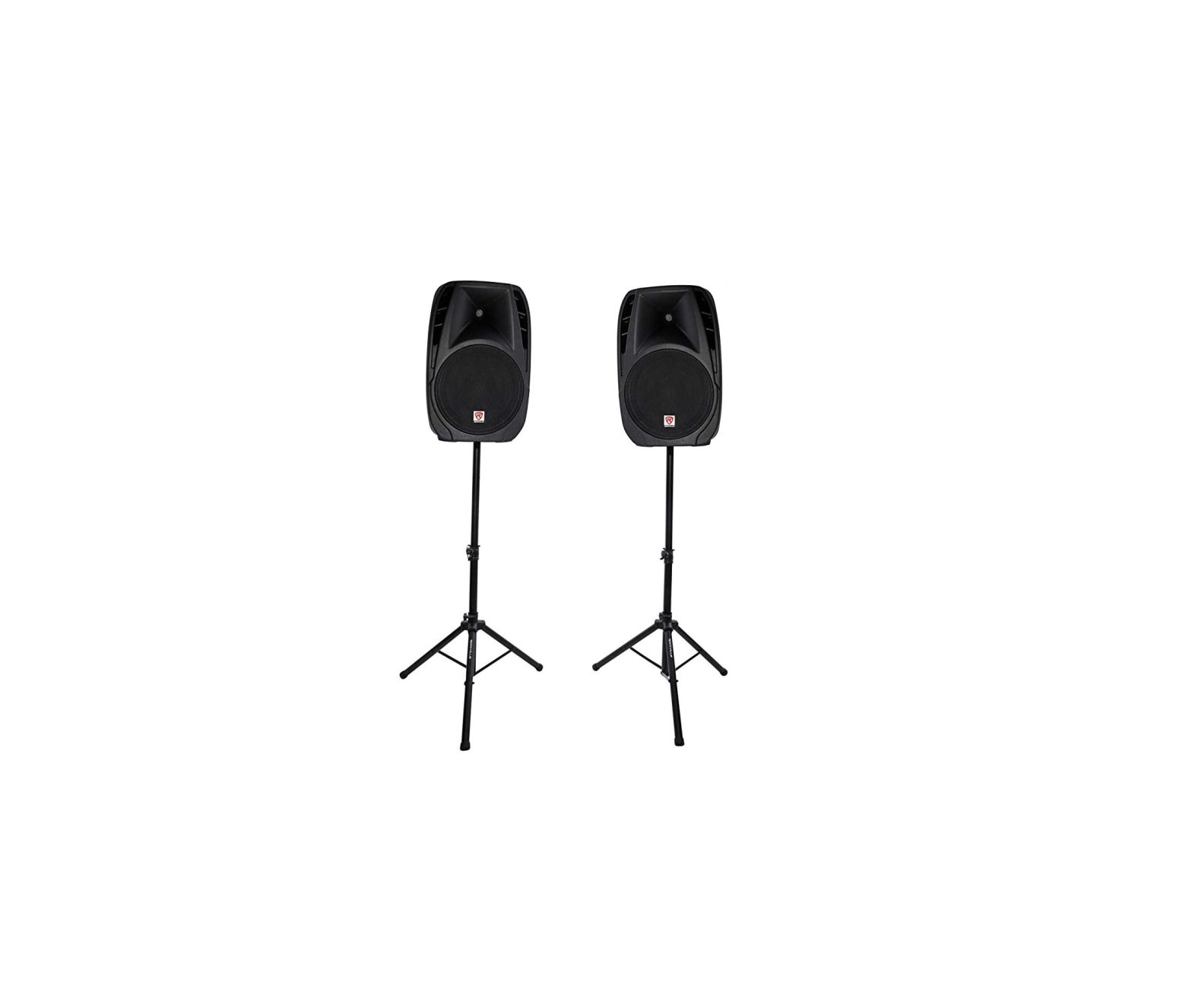ROCKVILLE RPG2x15 Portable PA System Owner's Manual
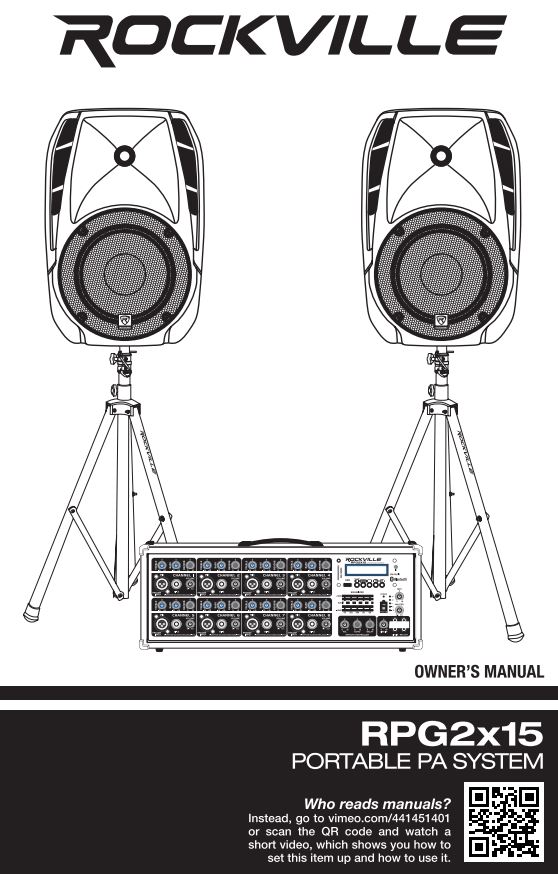
ROCKVILLE
Thank you for purchasing this Rockville RPG2x15 Portable PA System.
We are very proud to bring you what we consider to be the absolute best value in pro audio products. This project has been a culmination of years of development involving a team of dreamers, engineers, designers and marketing gurus. Proudly conceived and developed in the USA, Rockville pro audio products are designed and engineered by a team of pro audio enthusiasts.
We have spared no expense in manufacturing these Rockville RPG2x15 Portable PA Systems to meet the highest quality standards. With proper care and installation these units will provide you with the highest levels quality. We hope that these units will bring you years of performance and reliability.
Please read this installation guide carefully for proper use of your Rockville RPG2x15 Portable PA System. Should you need technical assistance please call our technical help line at 1-646-758-0144, Monday through Friday, 9am to 5pm EST.

FEATURES AND SPECIFICATIONS
- Includes:
(1) 15″ ABS molded PA speaker (second speaker in separate box)(2) 8 Channel powered mixer(2) Foldable Speaker Stands(2) 1 O foot ¼” TS to ¼” TS Right Angle Speaker cables (100% OFC Copper)(2) Metal wired microphones(2) Mic clips(2) 10 foot XLR to XLR mic cables (100% copper)
- Speakers:
- Two 15″ premium professional long throw woofer with 2″ voice coils, and 40 Oz magnets!
- State-of-the-art 1″ Titanium Diaphragm Driver Tweeter
- Incredibly deep bass and clear sounding midst/ highs
- 350 Watts RMS / 700 Watts Program Power/ 1400 Watts Peak
- Molded plastic speaker cabinet for increased sound quality
- Two-way cabinet architecture
- Horizontal / Vertical position for use as stage monitor or PA speaker
- Impedance: 8 Ohm
- Pole mountable
- Frequency range: 55Hz – 20KHz
- Sensitivity: 94dB
- Input connections: one¼” jack and one speak ON jack
- Maximum SPL: 112dB
- Powder-coated steel grill
- Thick plastic feet protect the enclosures
- Speaker dimensions: 17 .5″ x 13″ x 27.1″
- Weight: 28.6 Lbs. each speaker
- Microphones
- Two Rockville RMM-XLR Dynamic cardioid microphones designed forstand-mount application
- Steel Mesh Grill
- On/Off Switch
- Rugged Metal Construction
- Natural Sound Reproduction
- Beautiful Black Finish (The perfect combination of matte and shiny black finish)
- Frequency Response: 50Hz-15kHz
- Super Cardioid Polar Pattern
- Impedance 600 Ohm ±5%
- Sensitivity -60d B ± 3d B (0d B= 1 V/Pa at 1 MHz)
- Mixer
- 8 Channel Powered Mixer with 1400 watt amplifier with built-in Bluetooth connectivity
- 17 Inputs
- USB / SD Input
- Bluetooth connectivity
- MP3 Playback
- LCD Display
- 350 Watts RMS / 600 Watts Program Power/ 1400 Watts Peak into 4 ohm (2 x 8 ohm) speakers
- 8 balanced XLR and ¼” microphone inputs
- Tape / CD Line inputs
- Master volume control
- Bass, treble, and reverb controls on each channel
- Volume control on each channel
- Digital delay and echo effect with independent volume control
- 48 volt Phantom power for condenser mies
- 5 band graphic equalizer
- Record Out for taping
- RF interference protection on all inputs
- Aux Send Output: -10 dBV nominal, 1 k ohms
- Tape Rec Output: -10 dBV nominal, 1 k ohms
- Input impedance: Low-Z Mic: 1 k ohms/ High-Z Line: 1 Ok ohms/ Tape Input: 1 Ok ohms
- Input Channel Equalization: +/- 15 dB @ 5 kHz
- Protection Circuit: Power on Mute delay (2 seconds)
- Mixer Weight: 26.4 Pounds
- Mixer dimensions in inches: 11 .6″x 19.6″x 7.6″
- 110/220 volt switchable
SETUP GUIDE
![]() Much of the setup of the Rockville RPG2x15 is similar to the setup of other sound systems, and many aspects require plain common sense. Safety should always be your first concern. Always use grounded outlets and three-wire extension cords. Run sound system cables in a way to prevent the danger of tripping and tape them down if needed. Place the speaker stands and mixer on a solid, level surface. Following these guidelines will help prevent personal injury and equipment damage, ensuring years of trouble-free use.
Much of the setup of the Rockville RPG2x15 is similar to the setup of other sound systems, and many aspects require plain common sense. Safety should always be your first concern. Always use grounded outlets and three-wire extension cords. Run sound system cables in a way to prevent the danger of tripping and tape them down if needed. Place the speaker stands and mixer on a solid, level surface. Following these guidelines will help prevent personal injury and equipment damage, ensuring years of trouble-free use.
Stands and Speakers
Remove the speaker stands from the case. Be sure the legs on the stand are fully extended to provide a stable base for the speakers and are positioned on a level surface. Tighten the thumbscrew on the base so that it is snug, but do not overtighten (figure 1 ). Raise the speaker stands to the desired height, tighten the thumbscrew and install the safety pin as shown in figure 2.
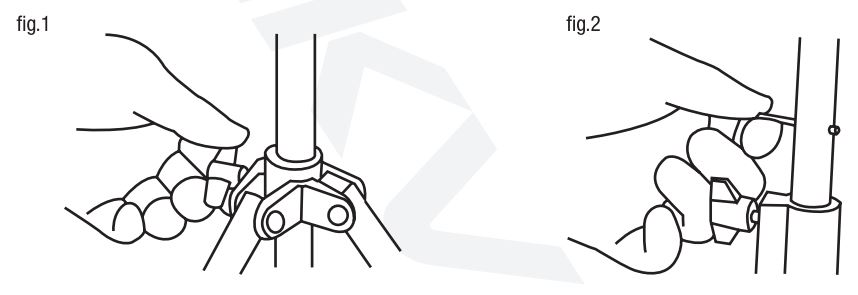
Place speakers on stands and position them so that they will face toward the audience and away from the microphones. Connect speaker cables from the jack on the lower front of the speaker to the speaker outputs on the back of the mixer. Connect the left speaker to the LEFT OUTPUT and the right speaker to the RIGHT OUTPUT.
![]() Only connect the included speakers to the mixer. The Rockville RPG2x1 S’s speakers provide optimal load for the powered mixer and using other speakers may result in equipment damage.
Only connect the included speakers to the mixer. The Rockville RPG2x1 S’s speakers provide optimal load for the powered mixer and using other speakers may result in equipment damage.
CONNECTIONS
Microphones and Line Inputs
The RPG2x15’s powered mixer is designed to work with any good-quality, balanced, dynamic or condenser microphone. Connect the included microphone(s) to the XLR (three-pin) input connectors as shown in figure 1. If using more than one microphone, connect them in the order they will be on stage for easy adjustment to each microphone. To connect a line level device such as a keyboard, use a 1/4″ instrument cable and insert into the corresponding 1/4″ jack as shown in figure 2.
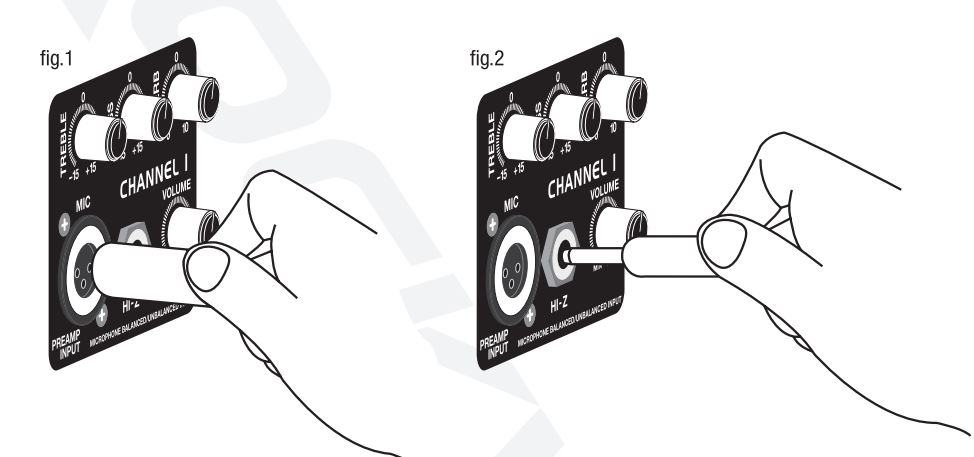
Media Playback Sources
The RPG2x1 S’s powered mixer will accept various media playback devices.
- To connect an MP3 player or smart phone with media playback capabilities use the LINE IN RCA inputs.
- To connect a turntable, a CD player, or any other line level device use any of the 1/4″ Hi-Z jacks or the RCA LINE IN input.
- To connect a USB memory stick or SD/MMC card use the corresponding inputs on the mixer panel. Use the screen and controls to navigate and playback audio files.
- To connect via Bluetooth, simply pair your device with the mixer.
Power
Connect the power cord to the receptacle on the back panel of the unit, and then to a suitable electrical outlet. If an extension cord is required, make sure it is a three-wire cord with an intact ground pin to preserve the safety ground.
GENERAL USE TIPS
Microphone Usage
When practical, a single microphone is preferred. Additional microphones pick up more sound from the speakers and each mic must then be turned down to prevent feedback. However, if you have difficulty balancing the level of different individuals with one mic or if you still cannot get sufficient gain, using more mies can offer an advantage. For example, giving several singers their own microphone allows placement of the microphones much closer to each singer. This increases the volume of the sound at the mic and far outweighs any detrimental effect from using multiple mies. It also allows the volume of each mic to be adjusted separately for proper balance.
Avoiding Irritating Feedback
The placement of your microphone is critical in avoiding feedback through the RPG2x15. Never set up your microphone in front of the speaker. Always set up your microphone behind the speaker. When approaching the speaker to make any adjustments, we recommend approaching the speaker from the rear and not walking directly towards the front of the speaker.

BASIC OPERATION
Setting Controls and Turning Unit On
Before turning on power, make sure all speakers, microphones, and other input devices are connected. Set Master Volume con to the 12 o’clock position and all other controls all the way down. Turn power on by placing the ON/OFF switch located on the back of the mixer to the ON position.
Adjusting Gain and Volume Controls
The optimal setting for the powered mixer and included speakers is marked on the MASTER VOLUME control. Adjust the CHANNEL VOLUME control until the desired volume is achieved. If the desired volume is reached with the CHANNEL VOLUME turned down to one of the first three positions, turn the MASTER VOLUME down so you can turn the CHANNEL VOLUME up. If the desired volume is achieved when the CHANNEL VOLUME is close to max then raise the MASTER VOLUME so you can lower the CHANNEL VOLUME. These are the same as any basic mixer functions.
Adjusting Tone Controls
For each active channel adjust the BASS and TREBLE controls to achieve desired sound. Use moderation when making these adjustments, as extreme high settings of any of these controls can lead to a distortion of the sound and an increased chance of feedback on microphone inputs.
(HIGH)
This High EQ shelving type of active tone control varies the treble frequencies (+/- 15dB at 12kHz) and is designed to remove noise or add brilliance to the signal, depending on the quality of the source.
(LOW)
A shelving type of EQ that varies the bass frequency levels(+/- 15dB at 80Hz). Low EQ adds depth to thin-sounding signals or cleans up the muddy ones. As with any EQ, use sparingly. Too much of this EQ can give you a booming bottom end.
EQUALIZATION AND EFFECTS
Graphic Equalizer
Unlike the BASS and TREBLE controls on each channel that adjust only that specific channel’s input signal, the five-band equalizer adjusts the tonal balance of all the signals going through the powered mixer. It offers control over 60Hz, 250Hz, 800Hz, 2KHz, 8KHz frequencies (+/-12d8) and offers flexibility in adjusting sound. This equalizer also helps reduce or eliminate acoustic feedback.

Effects
This unit has a built-in digital delay. It’s a reverb effect and features DELAY, ECHO, and VOLUME controls. The effect affects all channels (fig.1) and can be individually controlled at each channel using the REVERS control (fig. 2).
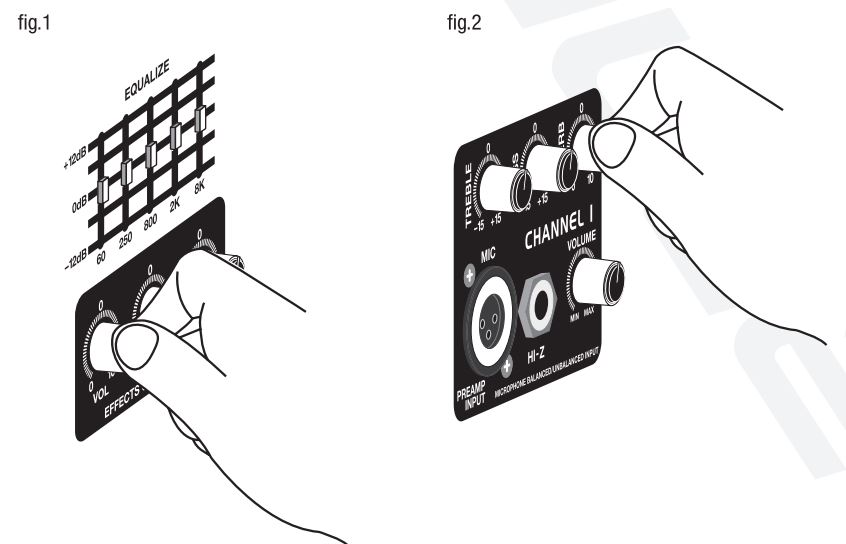
BLUETOOTH AND MEDIA
Bluetooth Operation
To listen to the music via the Bluetooth wireless connection, you must first pair (link) your RPG2x15 with your Bluetooth phone and/or music device. Turn off any Bluetooth devices previously paired with the RPG2x15. Turn on the Bluetooth feature on your phone or music device. Make sure the RPG2x15 is ready for a Bluetooth connection. The Bluetooth mode must be active. The LCD will say, “Bluetooth input”. Place your phone or music device in Bluetooth search mode. The phone or music device will begin searching for the RPG2x15. Select the unit, which should appear as Rockville, from the search results on your phone or music device. Select Ok or Yes to pair with your phone or music device.
Supported Audio File Types
- .WAY
- .MP3
- .WMA
Media Source Playback
Hook up your media source device as mentioned previously. Which inputs are active will be displayed on the LCD screen. Use the controls on the source device for play, stop, forward and reverse functions. Adjust corresponding channel controls on the mixer for desired sound. For media playback using an MP3 player, smartphone, or other similar device use the MODE button to navigate to the proper setting. Connect using a stereo 1/4″ cable to RCA or a 3.5mm to RCA cable and use the source device for playback controls. When adevice is connected to a 1/4″ jack the RCA jacks are automatically disabled. For audio file playback from a USB memory stick, use the MODE button to navigate to the USB setting. Use the LCD screen and controls to navigate and playback supported audio files. Use the controls on the mixer for play, pause, forward and reverse. Follow the same procedure for SD/MMC input.
If you do not choose to navigate or select a certain file the RPG2x15 will play the files in the order they are stored on your USB or SD/MMC memory device. Non-audio files will show up in your navigation but will have no audio playback if selected. Only audio files can be selected for playback.
Note: The RPG2x15 does not allow playback through multiple media inputs simultaneously.
FUNCTIONS

- Bass and Treble controls. Adjusts High and Low frequencies for the corresponding channel.
- Digital Delay Effect (reverb) control Reverb control.
- XLR microphone input. We recommend using professional balanced dynamic, condenser or ribbon mies as they are least likely to be affected by interference. Low cost, high impedance mies can be used, however the level of background noise is higher since an unbalanced circuit is far more susceptible to interference.
- Balanced 1/4″ TRS input. It accepts signals from a variety of sources such as keyboards, electronic drums, tape recorders, mixers, etc. It will not process microphone input. When you use an unbalanced 1/4″ TS plug, the line input automatically turns the ring into ground.
- Adjusts gain level for the corresponding channel.
- 5 band equalizer. Adjust frequencies to +/-12dB
- Digital delay effect (echo) control panel.• The Volume knob adjusts the mix level of the effect sound.• The Echo knob controls the echo interval.• The Delay knob controls the time interval of the delay.
- Line In volume control.
- RCA Line In / Record Out jacks.
- Master Volume control.
- MP3 (USB /SD/ MMC input) volume control.
- Volume level meter.
- Power indicator LED/ Phantom Power Button and indicator LED.
- IR receptor.
- LCD Screen.
- MP3 Player controls.• Press Play button once to play track, press again to pause. Press and hold to select folder when in USB / SD mode.• Mode control switches between input modes: Bluetooth, USB, SD / MMC.• Repeat Button.• Previous / Next track buttons also allow you to move between tracks.
- USB port.
- SD/ MMC port.
- 1/4″ speaker outputs.
- Power switch.
- Variable voltage selector switch (110v / 220v).
- IEC AC power socket.
TROUBLESHOOTING
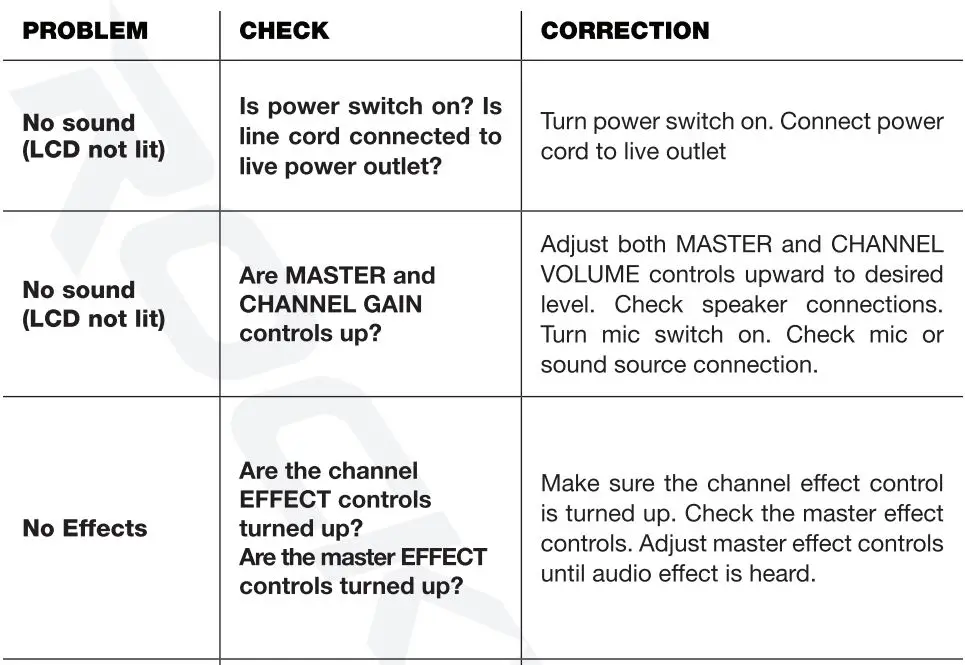
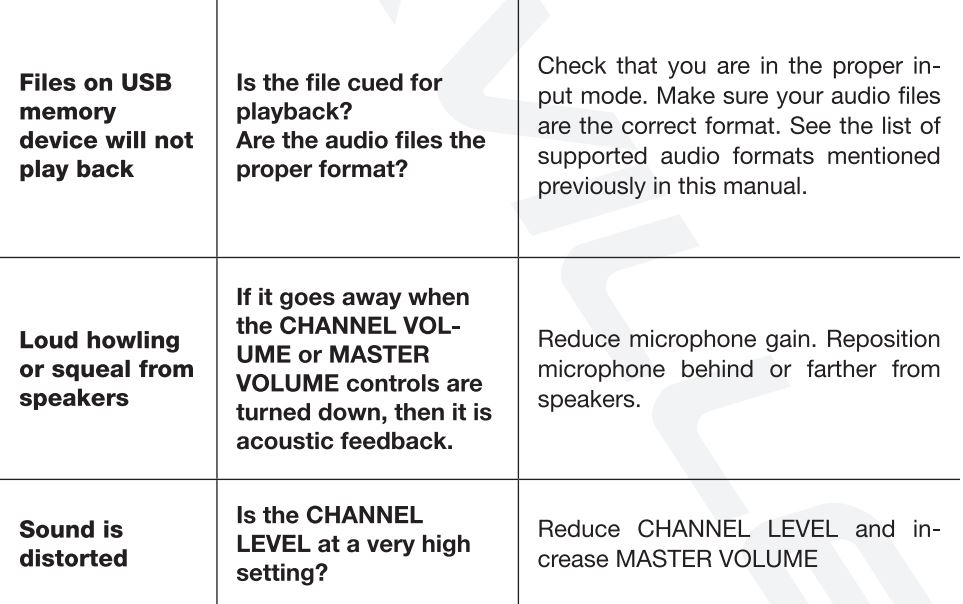
NOTES:
FEDERAL COMMUNICATIONS COMMISSION COMPLIANCE INFORMATION
Responsible party name: Rockville
Address: 600 Bayview Ave.Entrance AInwood, NY 11096
Hereby declares that the product{s) RPG2X15 Portable PA System complies with FCC rules as mentioned in the following paragraph:
This device complies with Part 15 of the FCC rules. Operation is subject to the following two conditions: (1) this device may not cause harmful interference, and (2) this device must accept any interference received, including interference that may cause undesired operation.
Note: This equipment has been tested and found to comply with the limits for a Class 8 digital device, pursuant to Part 15 of the FCC rules. These limits are designed to provide reasonable protection against harmful interference in a residential installation. This equipment generates, uses and can radiate radio frequency energy and, if not installed and used in accordance with the instructions, may cause harmful interference to radio communications. However, there is no guarantee that interference will not occur in a particular installation. If this equipment does cause harmful interference to radio or television reception, which can be determined by turning the equipment off and on, the user is encouraged to try to correct the interference by one or more of the following measures:
- Reorient or relocate the receiving antenna.
- Increase the separation between the equipment and receiver.
- Connect the equipment into an outlet on a circuit different from that to which the receiver is connected.
- Consult the dealer or an experienced radio/TV technician for help.
Visit us at:RockvilleAudio.com
Due to constant improvements, these specifications are subject tochange without notice.Copyright 2020
[xyz-ips snippet=”download-snippet”]

